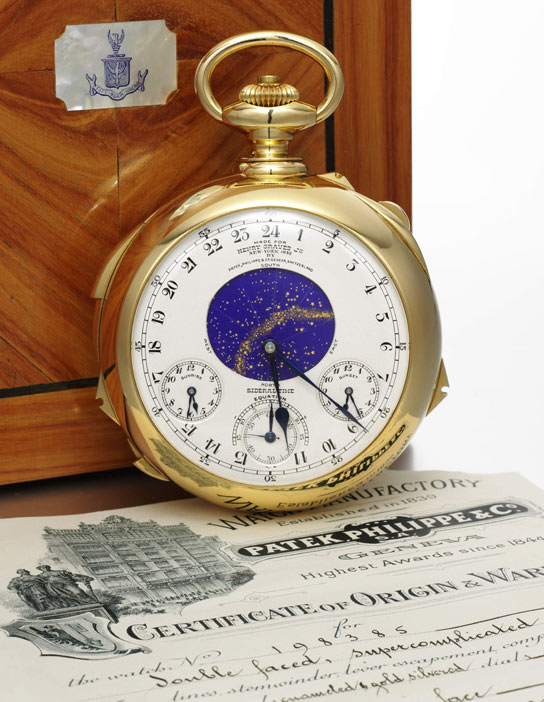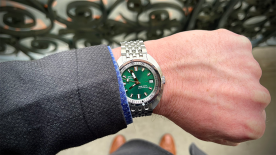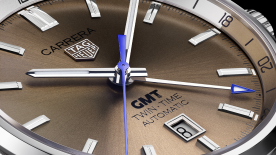Patek Philippe is considered, not only within the inner circle of passionate collectors and scholars, a monument. Rich in history, its path is paved with continuous innovation, unmatched craftsmanship and many legends. And, in all these disciplines, the venerable firm always shines with excellence. And this, exactly now in 2014, for 175 consecutive years.
Most of its godly splendour was achieved through its utterly spectacular creations which the family-owned manufacturer created for its most important and demanding clients: unique masterpieces, blessed with complications, artistic design and unparalleled quality. While some of the Geneva-based firm’s historic clients were celebrities from Hollywood, the world of sports or music, others were famous businessmen or crowned heads.
Henry Graves Jr. was a New York born banker, but even more so a passionate collector and sportsman. And it was Graves, together with the well-known automobile manufacturer James Ward Packard, who pushed Patek Philippe’s master watchmakers to their limits by demanding, repeatedly, year after year, more complex, more sophisticated Grande Complications. From an historical perspective, one must consider Graves as Patek Philippe’s most important patron.
The climax of this competition was achieved in 1933 (at the darkest moment during the Great Depression!) when Henry Graves Jr. eventually took possession of Patek Philippe No. 198’385, his massive, double-dialled masterpiece composed of 900 parts, weighing over half a kilo and boasting 24 horological complications. The price Graves paid was an impressive 60,000 Swiss francs. For over half a century, this watch remained the most complicated watch ever build before the computer age.

Graves passed away in 1953 and his family eventually sold his Supercomplication to Seth G. Atwood, prominent long-time collector of clocks, chronometers and watches and founder of the Time Museum in Rockford Illinois. In 1999, it was offered for the first time in public when Sotheby’s was given the privilege to sell selected highlights of the Time Museum. Against a presale estimate of US$3-5 million, the Henry Graves Supercomplication outperformed anyone’s expectations and sold to an anonymous private collector for US$11 million, until today the highest price ever paid for a watch.
Sotheby’s recently announced that it will be offering at auction the “The Holy Grail” Henry Graves Supercomplication in Geneva on November 11 and expects a result “in excess of 15 million Swiss francs”. Is this an appropriate amount or too much? Or possibly too modest?
For some time I have been thinking about the value of this treasure. Over and over, I remind myself that it is, thanks to its uniqueness, history, number of complications and, not to forget, its distinguished signature on the dial, the most valuable watch in private hands today. Full stop.
Certainly, there are other masterpieces by Breguet, such as the “Marie-Antoinette”, historical chronometers by Harrison or clocks by Thompion, to name just a few, which do deserve to be described as “historically utterly important and priceless”. However, these are locked away in museums around the world, with little to no hope of ever coming up for sale.
Certainly, 15 million Swiss francs is a lot of money, especially for a watch which, with all due respect, no one will ever wear. It is the equivalent of 50 lovely examples of Patek Philippe’s legendary reference 1518 in yellow gold, the number of watches which have been sold at auction during the last decade. More extreme, with this amount of money you can buy 1000 (yes, one thousand!) stainless-steel automatic Rolex Daytonas! What a terrible way of looking at things…
But then again, I analysed it from another perspective: it is less than half of what a collector recently paid for a Ferrari 250 GTO*, one of 39 examples produced! Or nearly a quarter of what Jeff Koons’ (a living artist!) Orange Balloon Dog fetched**! Again, not the right way of looking at things…
Personally, I believe there is only one way of concluding what is the right way of assessing The Graves’ value: simply put, it is priceless, meaning that I don’t think anyone can say what it is worth and, especially, what is too much for it. I sincerely hope that those amongst you, dear readers, who do have the necessary means “sleeping” somewhere on their savings account, realize that the Graves Supercomplication is worth every cent, no matter if the hammer price starts with a one, a two or even a three.
* US$38,115,000: Ten Important Motor Cars from the Maranello Rosso Collection, 14 August 2014, Bonhams, Carmel, California
** US$58,405,000: Post-War and Contemporary Evening Sale, 12 November 2013, Christie’s, New York







